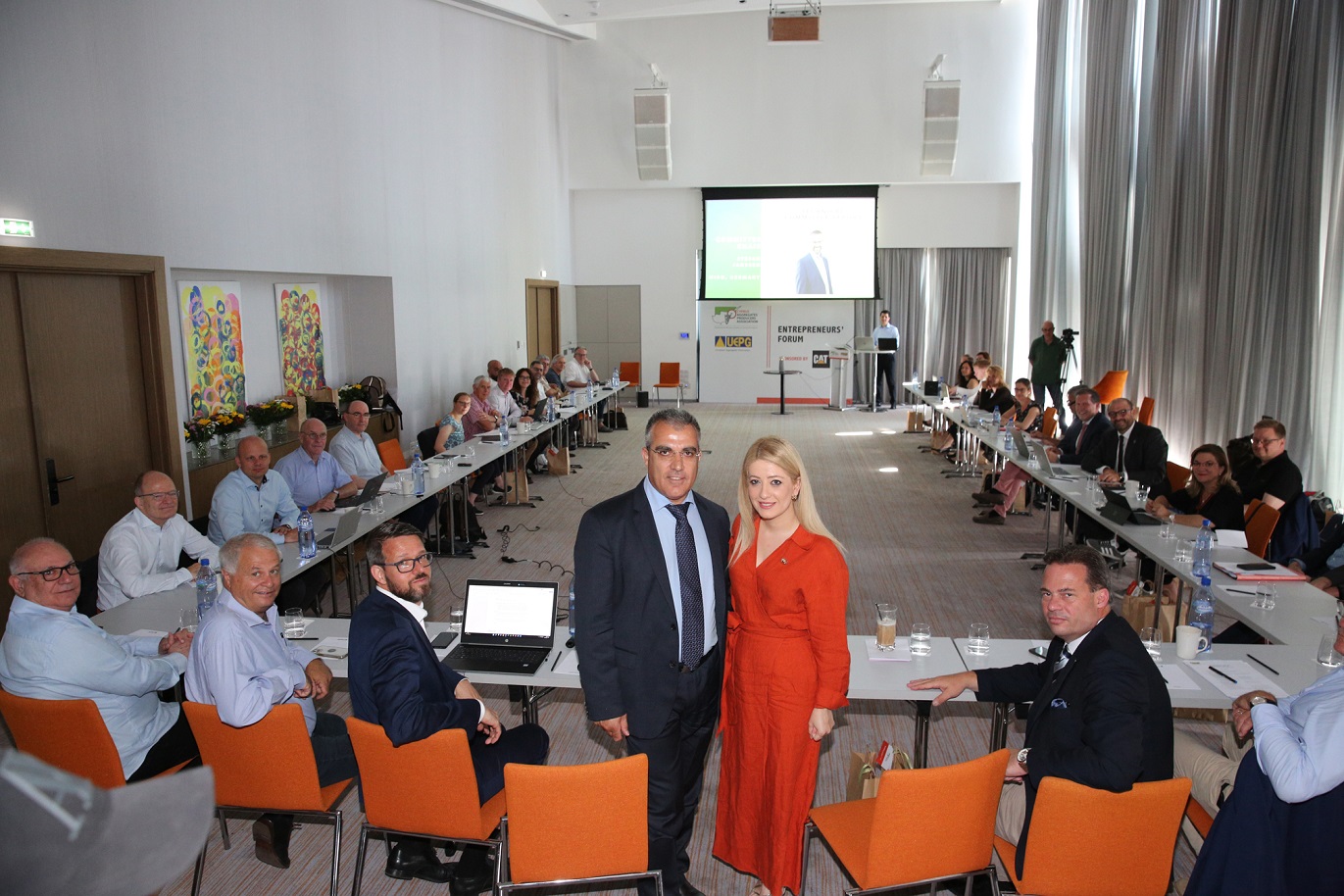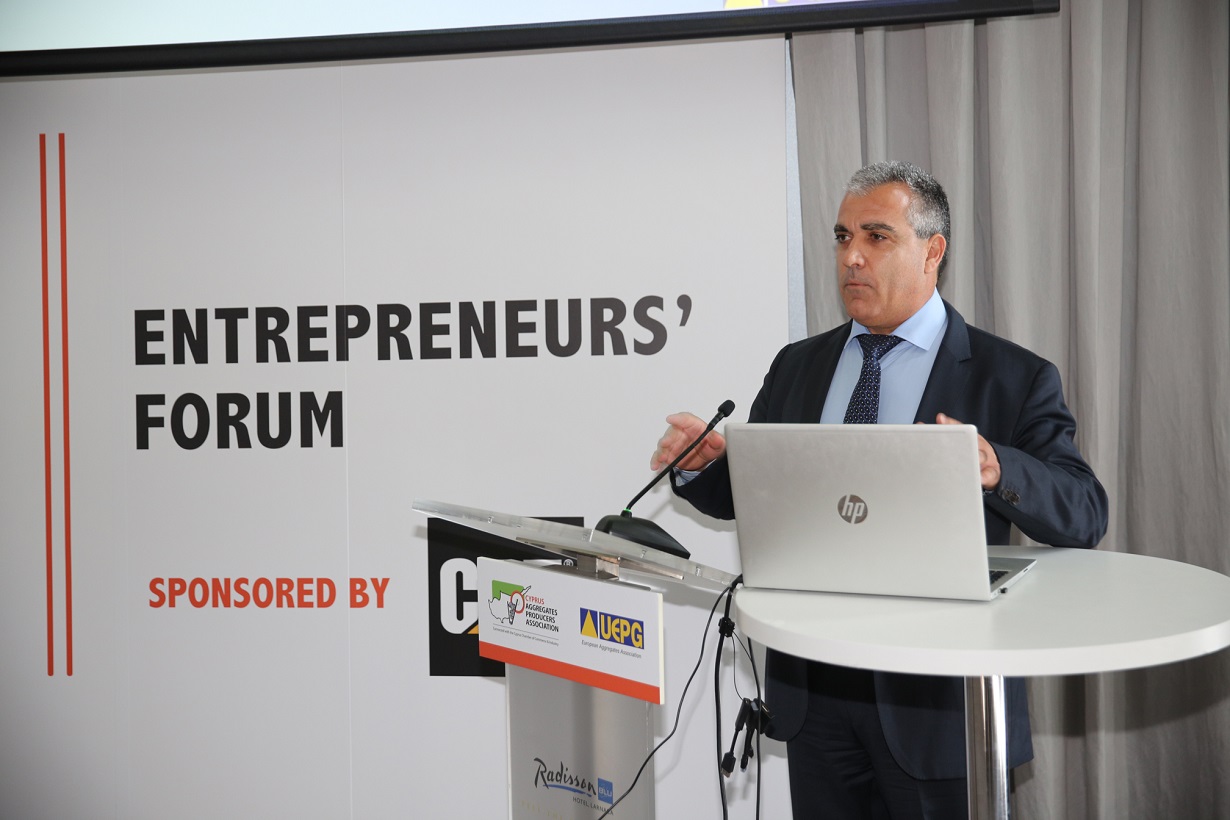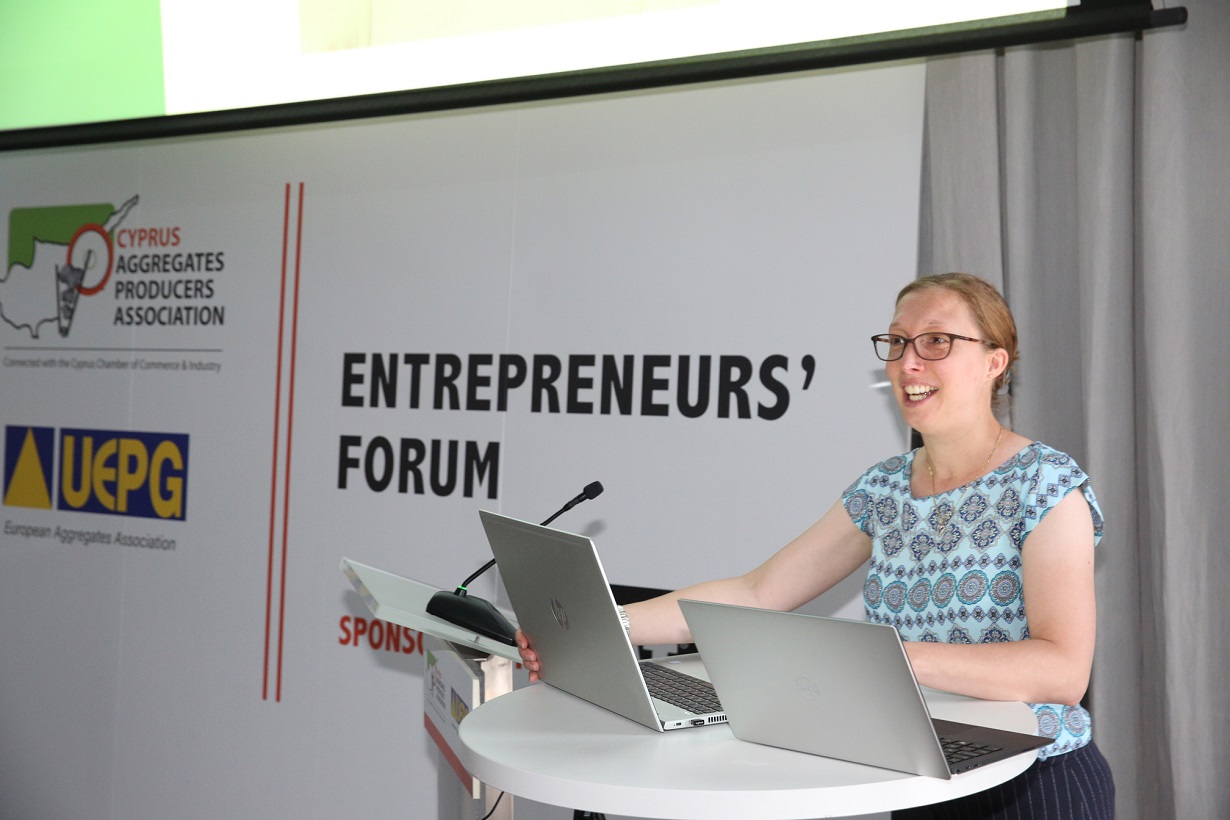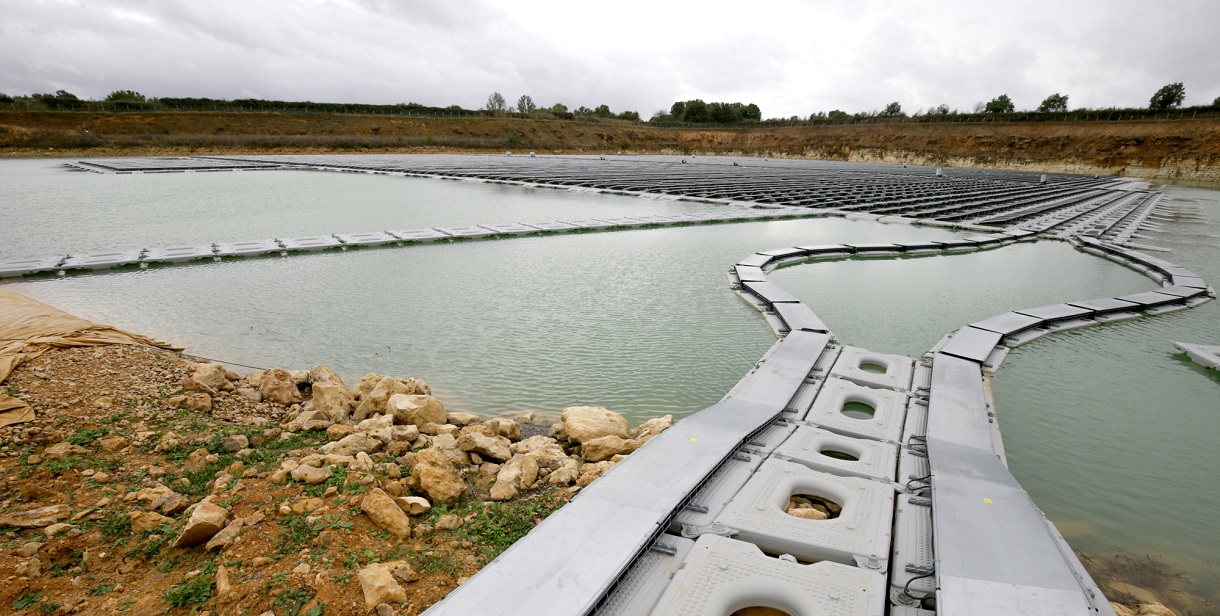
This year’s UEPG Congress in Cyprus was the first opportunity for the European aggregates industry association to hold the annual event fully ‘in person’ since the advent of the global pandemic.
The Congress, held in the coastal resort of Larnaca from June 16-17, also marked the UEPG’s 35th anniversary.
Issues high on the agenda included UEPG’s roadmap for the sector through to 2030, how far the use of recycled aggregates can progress, the impact of the Russian invasion of Ukraine on aggregates supply, and the increasing importance of solar panels on quarry lakes and wind turbines as an additional source of electricity – low cost and carbon-neutral.
It was a packed schedule and Aggregates Business was delighted to be invited along to listen in on some fascinating discussions that will help shape the industry and the wider world for years to come.
During his keynote address at the entrepreneurs’ forum on the first day of the event, UEPG president Antonis Latouros set out the association’s roadmap of its plans for the European aggregates industry going through to 2030.

Putting the importance of the industry to Europe in context, he said: “Aggregates build everything around us.
“If there were no aggregates there would be literally nothing around us. No roads, no ports, no airports, no buildings, no schools, no houses, no hospitals, nothing.” To build one average house we need around 400 tonnes of aggregates, for an average school we need around 3,000 tonnes, for a kilometre of motorway around 30, 000 tonnes.
“The European aggregates industry produces three billion tonnes of aggregates per year, worth more than €30bn. These aggregates are produced in 26,000 quarries around Europe, which belong to about 15,000 companies, so our industry mainly consists of SMEs. We have the big companies as members [of UEPG] but they produce only 5% of these three billion tonnes.”
Each European citizen consumes around six tonnes of aggregates per year and the industry employs around 187,000 people. The UEPG represents this sector which is by far the largest non-energy extractives industry in Europe.
There are a number of UEPG actions on its 2030 roadmap, which was initiated by former association president Thilo Juchem and launched in Brussels in September 2021 to identify the challenges and opportunities for industry over the coming years.
The roadmap sets out what the UEPG and its European aggregates-sector members need, what it promises and what it will deliver.
The first four actions concern what is needed. Firstly, the need to have access to sustainable local resources in order to have efficient transportation of its products, for both economic and environmental reasons.
“We are considered to be a low CO2 footprint industry,” Latouros says. “For each tonne of aggregates, we need around 3-5kg of CO2 but if we have to transport our products more than 40km we end up having more CO2 than during the production process. For this reason, it is better to be near to the point of demand.”
The second item on the roadmap is the need for streamlined/efficient national land-use planning and permitting policy. “Resources are everywhere in Europe, but accessing them is not that easy,” says Latouros.
Thirdly is the need for regulations facilitating a circular economy. “Recycling is part of our business model,” says Latouros.
Fourthly is the need for a level playing field for all through consistent implementation of EU law.
UEPG makes four promises in the roadmap:
• Professional representation of its industry, ever mindful of its predominantly SME membership
• Streamlined/efficient national land-use planning and permitting policy
• Responsible sourcing and excellence in delivering high-quality products
• Regulations facilitating a circular economy, increasing resource efficiency
In terms of what it will deliver, the UEPG commits to:
• Play an active role in climate change mitigation and adaptation
• Deliver on responsible environmental stewardship
• Deliver biodiversity net gain in both extraction and restoration
• Prioritise employee/contractor safety, health and wellbeing
• Foster better links and communications with local communities
• Further extend good-practice exchanges through the Global Aggregates Information Network (GAIN), helping make its industry more sustainable globally
In terms of efforts around climate change, Latouros said: “We will promote energy efficiency and electrification of our moveable machinery.
“This will come in a few years’ time that we will have these big monsters fully electrified. We will also promote the production of renewable energy on-site.”
The UEPG’s delegates assembly was attended by several senior Cypriot political figures. These included the President of the Parliament of Cyprus Annita Demetriou, the Minister of Agriculture, Rural Development and Environment Costas Kadis, the Commissioner of Environment Klelia Vasileiou, and the Mayor of Larnaca Andreas Vyras. In her speech Demetriou told delegates of her pride that the small island of Cyprus had taken over the leading role in representing Europe’s extractives industry in the person of Antonis Latouros.
The assembly is held to decide on strategy issues around the association. The UEPG office in Brussels is well-placed to interact with the EU’s lawmakers, being only five minutes walking distance from the European Parliament.
The association has members in 26 countries. “We bring all these countries to the same table to make decisions and work for the best benefit of our industry, but to an extent for the best benefit of humanity because we are producing an essential product,” says Latouros.
“We have four main committees: health & safety, environmental, technical and economic. With 26,000 extraction sites in the industry, we have the luxury of having the best of the best in experts to deal with these specific issues.”
He stresses the need for global cooperation among aggregates industry players. Along with all other major industries, recent geo-political events have major implications for aggregates.

The Russian invasion of Ukraine has combined with the drive for sustainability to bring Europe’s dependency on raw materials such as aggregates and energy increasingly to the focus of high-level attention.
“The invasion shifted European and national policy priorities,” said Aurélie Delannoy, chair of the UEPG economic committee. “The EU will develop a sort of war economy. To meet these challenges raw materials will be needed.”
Delannoy said that the European aggregates industry has an important part to play in these issues: “We need sustainable finance, in addition to the immediate recognition of aggregates as being essential and strategic raw materials - and this being recognised in land-use and permitting procedures.”
The UEPG has developed a position paper setting out the role the aggregates sector can play in a ‘green and secure’ Europe in this changed landscape.
The paper states that military mobility needs better and new infrastructure including roads, bridges, rail-tracks, airfields and ports. It adds that this should be undertaken with respect to climate-friendly renovation, low-carbon transport and e-mobility.
“Our production is low-carbon and should become climate-neutral as laid out in our Roadmap to 2030,” says Delannoy. “Aggregates producers are increasingly producing and using renewable energy, promoting alternative fuels and the electrification of machinery. Our 26,000 extraction sites have great potential to become green stepping stones helping to connect nature-protected areas.”
In May the European Commission published the REPowerEU Plan, the EU’s response to the global energy market disruption caused by the war in Ukraine with a view to reducing dependency on Russian fossil fuels, in particular gas. Delannoy says that energy-intensive industries such as aggregates can significantly contribute to and benefit from the REPowerEU efforts.
Replacing coal, oil and gas in industrial processes will help cut the fossil fuel dependency, while transitioning to cleaner energy sources, strengthening industrial competitiveness, and supporting international technology leadership.
Petra Gradischnig, MD of the Austrian aggregates association and chair of the UEPG Biodiversity Task Force, said that a key priority of the aggregates industry is to protect biodiversity around its sites and ensure that materials extraction and biodiversity can go hand in hand.
To this end UEPG is a partner of EU biodiversity policies. These include the Flora-Fauna Habitat Directive and Birds Directive, which are the core of the EU’s nature conservation policy and are part of its Natura 2000 network of protected areas covering Europe's most valuable and threatened species and habitats.
In May 2020 the EU published its Biodiversity Strategy – part of its Green Agenda – which targets 30% of land and sea in Europe being protected areas by 2030. “At the moment around 26% of land and 11% of sea are protected areas, so there is still a lot of work to do,” said Gradischnig.
She added that the aggregates industry can make a significant contribution as a partner for the biodiversity strategy: “Our sites host wild pollinators such as bees and butterflies, and there are also several live projects conducted by our sector that demonstrate the compatibility between aggregates extraction and nature conservation.”
A further part of the Green Agenda, aggregates recycling, was a major focus of discussion during the UEPG event. Brian James, special advisor at the UK Mineral Products Association and chair of the UEPG recycling task force, said that getting back to basics is essential for successful recycling in the quarry industry, and for the circular economy objective of getting construction and demolition waste back into beneficial use.
“In order to recycle material, you must have a source of material to draw upon,” said James. “You must meet the technical requirements for everything you are going to do. It is the same standard that covers all the materials, whether they are recycled, manufactured or primary materials.”
James added that the current increasing cost of fuel means it is ever more important that the cost-effectiveness of the recycling process is taken into account. “Fuel costs at the moment make transport and processing serious considerations,” James said.
He said that urban locations make sense to carry out recycling as this is where most of the demolition activity takes place that produces the material for recycling.
He gave the example of the UK, where it is estimated that the country currently recycles around 25-30% of its aggregates demand. Other countries within the EU are also doing well, in particular Belgium and the Netherlands which are also in the 25-30% range in terms of recycling aggregates, according to UEPG estimates.
“C&D waste complements the supply of primary aggregates, it does not replace it,” he added.
He said the amount of material that can be recycled depends on the amount that becomes available through C&D activity. The current EU target is for 70% of aggregates to be recycled, and Netherlands is looking to go completely circular in recycling of aggregates by 2050, but James thinks such ambitious targets may not be possible to achieve: “You’ve got to have primary materials to meet the demand of certain areas.
“If you want very high-strength concrete you have to think a bit more carefully about the quality and consistency of the material, and whether you can justify the potential for increased usage [of C&D waste] in cement content. Use the recycled material for the best purposes that it is there for.
“My personal view from my background in construction is do not use recycled aggregates in over-specified areas. Do not use it for high-strength concrete, it will not have the required consistency. Use it where there is a bulk of material, and that is typically in highway construction or if you are doing harbour works where you have got to have ground development. It is excellent in these situations.”
In terms of whether the use of recycled aggregates should be specified in contracts, James says this can cause problems: “If you specify everything must have 25% recycled content the failure is, if it’s not available or if it is an awful long way away, it breaks all the rules that we are trying to adhere to. So be realistic. Don’t put it in the contract – put recommendations in by all means.”
Michael Tost, chair of mining engineering and mineral economics at the University of Leoben in Austria which works with UEPG on aggregates research, also thinks that a 100% aggregates recycling rate is not achievable. “I would even challenge a 60% recycling figure based on the data that we have at the moment,” he added.
Carsten Karcher, secretary general of the European Asphalt Pavement Association (EAPA), spoke to delegates about his work at the industry representative group. He stressed it is not possible to be in the asphalt sector these days without being responsible and sustainable.
“Asphalt plants are highly regulated all over Europe by national authorities and ministries. They have to meet environmental certificates and permit requirements. This is all related to the health and safety of the neighbourhood, and of the workers employed there.”
He said that asphalt is a highly engineered and technological product, being a mixture of aggregates, the bitumen that binds it together, and some additives. “Ninety-five per cent of the roads in Europe are paved with asphalt, they are the veins of Europe,” said Karcher.
He added that asphalt is a high-level material, which makes it suitable for recycling and helping to drive the circular economy.
The European Commission’s ambition is to cut greenhouse gas emissions by at least 55% by 2030 and set Europe on a path to becoming climate neutral by 2050. Karcher said that industries across the region are some way from this, but added that both the asphalt and aggregates sectors have the tools available to achieve these ambitious targets.
A recent survey of 14 EAPA national members found that, of the total 27.4 million tonnes of reclaimed asphalt that is available, 64% is re-used in hot-mix asphalt, 33% is recycled and only a maximum of 3% is sent to landfill.
The current European average for CO2 produced during asphalt production is 40kg per tonne. A tool for calculating CO2 emissions in asphalt production is already in use in Scandinavia, where producers are given credits during the bidding process for lower emissions. “There is a competition between the asphalt mix producers to have ‘greenest’ asphalt and this is usually the one that gets the job,” Karcher commented. He called on legislators elsewhere to also mandate the use of a CO2 emissions tool in the bidding process. “It’s important as there has to be pressure on the industry,” he said.
The temperature at which asphalt is heated during production has a massive effect on CO2 emissions. “Every ten degrees that you reduce the temperature reduces the emissions by 50%,” said Karcher.
He said manufacturers should not overheat asphalt during production just to be able to transport it further to jobsites that are a long distance from the plant.
He added that there is room for improvement in the distances material is moved in the asphalt sector. Across Europe the average distance for aggregates to be transported to an asphalt mixing plant is approximately 50km, and then a further 50km from the plant to the jobsite. To reduce the accompanying CO2 caused by these long distances, Karcher said asphalt producers should consider using different quarries that are in closer proximity to the plant for certain applications, or to carry out more recycling of asphalt at jobsites in cities and on highways.
“We can do even more, such as using energy with electric vehicles for transport from quarries,” he added.
At the UEPG delegates assembly on the second day of the congress, members heard the latest updates on the UEPG’s health & safety, environment, technical and economic activities.
César Luaces Frades, chair of the UEPG health & safety committee, said the association is assessing the impact on the aggregates sector of a potential update of the European Union’s carcinogens and mutagens at work directive. “We know that this is affecting a lot of quarries in some countries, and it is an emerging topic on the agenda,” he added.
He stressed the importance of UEPG member countries sending their inputs about the impact of the potential revision on the aggregates industry, as it is critical for the association to have the necessary data to establish its position on the issue.
In terms of its environmental work, UEPG is focused on the impact on the industry of the EU Biodiversity strategy. In January this year, the EU published guidance on protected areas which sets the target of protecting 30% of EU land and sea by 2030. The EU adds that one third (10%) of this, areas of very high biodiversity and climate value, should be under strict protection.
There is good news for the industry in the removal of an initial European Commission proposal that forbade access to any extractive activities in strictly protected areas. This was not included in the January guidance, and UEPG’s former public affairs officer Sergiu Scolobiuc said this was due to the association’s work on the issue.
“It now employs more flexibility with a case-by-case approach,” said Scolobiuc. “There are exceptions for very small-scale sites which are essential for local communities, and I think aggregates would definitely fit in this definition.”
The designation process for protected areas has already started in several EU member states, and the UEPG is recommending that its members monitor and become involved in this process if possible as it can make a difference for the industry.
In February 2022 the association launched an ad hoc working group for biodiversity indicators to set a baseline for the aggregates industry by 2025. The group will collect data on biodiversity from designated pilot quarry sites in the lead-up to 2025.
The EU-funded “Life in Quarries” project, which has run at quarries in the Walloon region of Belgium since 2015 and expanded to two quarry sites abroad, has now been completed. A second edition of the project, whose aim is to develop and make sustainable the hosting capacity of biodiversity in various quarries, is currently being planned.
The EU published its Soil Strategy in November 2021, with the objective of achieving healthy soils across the European Union by 2050 with concrete actions to be taken by 2030. The strategy includes more than 80 actions, including voluntary and legally binding measures to be implemented by 2030.
The UEPG is focusing on the elements of the strategy with the greatest relevance for the aggregates industry. These include a new Soil Health Directive to be implemented by mid-2023, which is open for public consultation until the end of the third quarter of 2022.
In addition, there is a legally binding “soil passport” to boost the circular economy in streams of excavated soils, which is highly relevant to the aggregates industry. There are also cross-cutting actions in the Soil Strategy linked to water, pollutants, and biodiversity that UEPG will also be monitoring.
The association is proposing to set up an ad hoc working group to address this development in legislation.
A further environmental issue that is of importance for the aggregates sector is the increasing use of floating solar panels (floatovoltaics) on extraction-site lakes. The issue has assumed even greater relevance after the Russian invasion of Ukraine and ensuing threats to the supply of power to European countries.
Scolobiuc said: “In countries such as Belgium, Germany, France and the Netherlands there is great interest in having floatovoltaics on quarry lakes. It’s a great opportunity for our industry.”

The UEPG is currently working on a statement for external communication on the use of floatovoltaics in extraction-site lakes, in view of their potential environmental impacts and benefits.
At the end of March, the EC set out a proposal for a new Construction Products Regulation (CPR) that lays down harmonised rules for putting construction products on the EU market. The new proposal changes a lot of areas that impact the aggregates sector according to Stefan Janssen, chair of the UEPG technical committee. “They want to implement the European Green Deal goals, so sustainability and providing environmental data is key and a big part of the CPR,” he says.
Janssen says new regulation will mean that quarry operators will face additional site visits from EU notified bodies that specialise in environmental data, on top of the technical standard ones they currently deal with. “There will be a lot of additional general product and safety information you have to give,” he says. “Every device you have that has an impact on the carbon footprint has to be in your data and this needs to be up to date.”
It is proposed that if businesses have more than two ‘non-compliances’ with the CPR regulations the notified body will not issue the business with a new certificate for at least one year, meaning they will have no approval to supply CE-marked products (signifying that they meet EU standards) during that period. Janssen says: “I don’t know if they realise what they are doing to business, because businesses will crash if they are not able to deal with CE-marked products for one year. It makes no sense.”
Perhaps just as well then that there appears to be plenty of time for further revisions of the new CPR proposal as it has a transition period that runs through to 2045.
UEPG secretary general Dirk Fincke reported that the University of Leoben provided an update on the university’s 2010 review of the European aggregates industry. The 2010 Leoben Review was UEPG’s contribution to implement the EU Raw Materials Initiative’s 2nd pillar on improving access to domestic raw materials including aggregates, and reviewing land-use planning and permitting procedures.
Over a decade later, Fincke says the EU Industrial Strategy now recognises dependency on (domestic) raw materials and has identified construction as one of the 14 industrial ecosystems to focus on.
UEPG has worked on achieving this recognition with industrial alliances promoting the raw materials industry, particularly Industry4Europe. “UEPG’s strong involvement paid off with the updated Industrial Strategy and the recognition of Europe’s dependency on domestic raw materials,” Fincke added.
Going forward, he said that aggregates are an essential resource for the EU to achieve its sustainability objectives: the Green Deal and renovation wave, the strategy on climate change adaptation and the recovery plan fostering a green and digital transition of Europe’s economies require massive additional amounts of aggregates.
In line with the UEPG Roadmap to 2030, Fincke said the association is undertaking a review on land-use planning and permitting procedures to have a dedicated response on what is needed to ensure the responsible and sustainable supply of strategic and essential resources needed for the EU sustainability policies and strategies.
Michael Tost of the University of Leoben in Austria was commissioned to update the 2010 Leoben Study and has sent out questionnaires and requests for online interviews to UEPG members to collect data and input on anything new since 2010. Tost says their feedback is vital: “We will need scientific data for some issues, i.e., to propose a solid baseline, convincing, credible and realistic CO2 emissions reduction targets, actions that will allow companies and therefore the sector to move forward, and consequently to position aggregates as an opportunity for Europe and not as a threat.”
UEPG president Latouros said he and Dirk Fincke have already visited half of its member nations and the target is to go to all of them, starting with the Scandinavian and Baltic nations in September.
UEPG treasurer Leonie van der Voort said that March 2022 has seen the UEPG General Secretariat move to a new office, located on Square de Meeûs in Brussels. The European Asphalt and Pavement Association (EAPA) is joining UEPG at the new premises.
The association is planning a new logo and improvements to its website, in addition to recruitment efforts which include the appointment of two new public affairs officers, and Regina Madonna being appointed as its new PR & communications officer.













